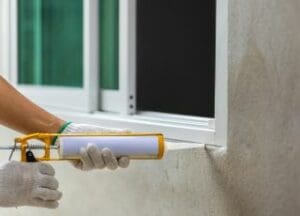What Is A U-Value?
When it comes to building or renovating a property, one of the key considerations is ensuring that it is energy-efficient to help keep running costs down.

When it comes to doors and windows, the U-value is a critical measurement.
However, it can actually be used to determine how well a building's insulation can resist heat transfer as a whole too.
This article from our Value Doors experts will explain what U-values are, how they are calculated, and why they are essential to creating energy-efficient buildings.
U-Value Definition:
Here's one for the energy efficiency boffins:
A U-value is a measure of the rate of heat transfer through a building element (such as a wall, roof, or window), expressed in watts per square metre per degree Celsius (W/m²K).
It is used to quantify the insulation and thermal properties of building material, with lower U-values indicating better insulation.
U-values are used to assess the energy efficiency of a building and are a critical factor in building regulations.
U-Value GCSE Definition Answer:
Just to make it slightly easier to understand or to make you feel old, at the GCSE level, students learn about U-values as a measure of the thermal insulation properties of building materials.
Specifically, a U-value is defined as the rate of heat transfer through a given area of a building element for every degree of temperature difference between the inside and outside of the building.
U-values are expressed in units of watts per square metre per degree Celsius (W/m²K), with lower values indicating better insulation.
In addition to being an important concept in GCSE-level science and technology studies, understanding U-values is also essential for building designers and engineers, as well as those involved in the construction and maintenance of buildings, as it helps to ensure that buildings are energy-efficient and compliant with building regulations.
Why is U-Value important?
If you want to ensure that your home keeps the heat in and the cold out then U-values are so important to keep energy bills down.
U-values are essential for determining how well a building can retain heat and, therefore, how energy-efficient it is.
By improving a building's U-value, energy consumption can be reduced, which not only saves money but also reduces greenhouse gas emissions.
U-values are also crucial in ensuring a comfortable indoor environment by preventing heat loss and drafts.
How is U-Value calculated?
U-values are calculated by measuring the heat flow through a building element, such as a wall, and then dividing the average heat flux through it by the temperature difference between the indoor and outdoor environments.
This calculation takes into account the thickness and thermal conductivity of the building material, as well as any air spaces or insulation within the element.
U-Values For Doors
We might as well drop in here that all our composite doors and bifold doors have some of the lowest U-values on the market in the UK.
Most think that a U-Value applies to windows only, but that would be wrong! U-Values can be applied to most building products, especially doors.
In fact, the industry regards U-Values as the most accurate way to measure the energy efficiency of a door.
You will see U-values most used on composite doors. Manufacturers often display the U-Values of their particular doors in their marketing literature.
The lower the U-Value for a door, the better! A good U-Value to aim for is around the 1.6W/m2K mark.
That is quite low by today's standards and will ensure your hallway or kitchen benefits from keeping that all-important and expensive heat inside!
U-Values For Windows:
Windows is one of the main products that U-Values are associated with. As with doors, the lower the U-Value new windows have, the less heat they are going to leak and for some people more importantly, also stop condensation on windows building up in the cold winter months.
There is another way of measuring the energy efficiency of uPVC windows, which is the Window Energy Ratings scale or WER's.
However, the industry still maintains that U-Values for windows are the most accurate way to measure heat loss and so remain the most important statistic.
When looking at U-Values for windows it is important to look for the lowest numbers possible. With the quality that is out there today, U-Values of around 1.6 or lower are really good
U-Values for windows are going to play a more and more important role in the future. Our industry is working very hard
to keep improving the products we sell, trying to lower U-Values and save even more of that oh-so-precious heat!
How to Improve Insulation Using U-Value Calculations:
U-value calculations are a valuable tool for enhancing building insulation.
These calculations enable the identification of heat loss areas in walls and windows, indicating where insulation needs improvement.
Upgrading insulation in areas with high U-values can reduce heat loss, leading to lower energy bills and a more comfortable indoor environment.
Additionally, such insulation upgrades can decrease a building's carbon footprint, helping mitigate the effects of climate change!
Therefore, U-value calculations are crucial in improving building insulation and promoting energy efficiency.
U-Value Formulas To Remember:
The basic formula for calculating U-value is:
U-value = Heat loss (W) / (Area (m²) x Temperature difference (°C))
U-value can also be calculated using the thermal resistance (R-value) of a material:
U-value = 1 / R-value
For composite elements such as walls or roofs, the U-value is calculated as a weighted average of the U-values of each layer:
U-value = (U1 x A1 + U2 x A2 + ... + Un x An) / (A1 + A2 + ... + An)
When we want to calculate the U-value of a wall or roof, we have to think about all the different layers that make it up.
For example, a wall might have bricks on the outside, insulation in the middle, and plasterboard on the inside. Each layer has its U-value, which tells us how well it insulates.
To work out the overall U-value of the wall, we need to take an average of the U-values of all the layers.
We do this by multiplying each building element's U value by the area of its layer, adding all the products together, and then dividing the total by the total area of the wall.
Remembering these formulas and calculation methods can help you to calculate U-values accurately and make informed decisions when selecting building materials for energy-efficient construction.
How To Measure The U-Value Of My Home?
Here are the step-by-step instructions for measuring the U-value of your home:
- Gather specialised tools: You will need a heat flux meter and an understanding of thermal resistances.
- Understand R-values: The lower the U-value, the higher the R-values. R-values are crucial in establishing construction strategies.
- Measure each building component: Each building component transmits heat differently. To accurately evaluate the U-value of the building construction, you need to measure the thermal transmittance in each square meter.
- Measure U-value for each particular component: It's important to measure the U-value of each particular component as different building components may have different U-values.
Understanding the Units of U-Value:
U-values are expressed in watts per square metre per degree Celsius (W/m²K), which means that they indicate how much heat is lost per unit of surface area for every degree Celsius of the temperature difference between the inside and outside of the building element.
Factors Affecting U-Value:
Several factors can affect the U-value of a building element, including the thickness and thermal conductivity of the material, the presence of air spaces or insulation, and the surface area of the element.
This can also include the opening of bifold doors, for example, as different opening options will affect the structure of the bi-fold and, therefore, the U-value.
Additionally, the orientation of the element and the prevailing climate conditions can also affect the building element's U-values.
Different Types of Insulation:
Several different types of insulation materials can be used to improve a building's U-value, including mineral wool, polystyrene, and polyurethane foam.
Each material has its own set of properties that affect its insulation and thermal performance too, such as its density, thermal conductivity, and water resistance.
Benefits of Energy Efficiency:
Improving a building's U-value can provide a range of benefits, including reduced energy consumption, lower heating bills, improved indoor comfort, and reduced environmental impact.
Energy-efficient buildings are also more valuable and attractive to buyers or tenants, making them a great investment!
For example, composite doors being energy efficient is one of the biggest benefits that they have, helping homeowners to save money on their energy bills for years!
Common Misconceptions about U-Values:
There are several misconceptions about U-values, such as the belief that thicker walls or windows necessarily provide better insulation.
While thickness is one factor that can affect U-values, other factors, such as the material's thermal conductivity and the presence of insulation, are also crucial.
Additionally, U-values do not indicate a building's air tightness or its ability to prevent moisture infiltration.
Conclusion:
U-values are a critical measure of a building's insulation performance and, therefore, its energy efficiency.
By understanding the basics of U-values, builders and homeowners can make informed decisions about building materials establish construction strategies and techniques, and improve the comfort, sustainability, and value of their properties.
It will also mean you are more environmentally friendly and end up saving more on your heating and electricity bills when getting as low a U-Value as possible on your doors and windows.
Frequently Asked Questions:
What is a good U-value for a building element?
A good U-value depends on the type of element and the local climate conditions. Building regulations typically set minimum U-value standards that must be met, but more energy-efficient buildings may aim for lower U-values.
What is the difference between U-value and R-value?
U-value and R-value are both measures of insulation performance, but they use different units of measurement. U-value measures the rate of heat transfer through a building element, or average temperature difference while R-value measures the resistance of a building element to heat flow.
Can U-values be improved after construction?
In some cases, it is possible to improve a building's U-value after construction by adding insulation materials or sealing gaps and cracks.
Are U-values important in the Building Regulations Approved Document?
Yes, U-values are important in the Building Regulations Approved Document. They are used to set minimum standards for the energy efficiency of building elements such as walls, roofs, and windows.

The Approved Document contains guidelines on the maximum U-values that are allowed for each construction element used in different types of buildings. Meeting these standards is a legal requirement for all new buildings and major renovations in the UK. This helps to ensure that buildings are constructed to be energy efficient, which can save money on heating and cooling costs and reduce carbon emissions.
What factors can affect the U-value?
Several factors can affect the U-value, including the thickness and thermal conductivity of the material, the presence of insulation or air spaces, how good a material is, the surface area of the element, and the prevailing climate conditions.
What is R-Value?
R-value is a way of measuring how well a material can keep heat inside a building. It shows how much the material resists heat flowing through it. The R-value is measured in m²K/W units, and a low U-value corresponds to a higher number which means better insulation. The R-value is used to work out how energy efficient a building is, just like U-value.
In the UK, U-value is used more often than R-value, but they both do the same job. The higher R-values mean better thermal resistance.









